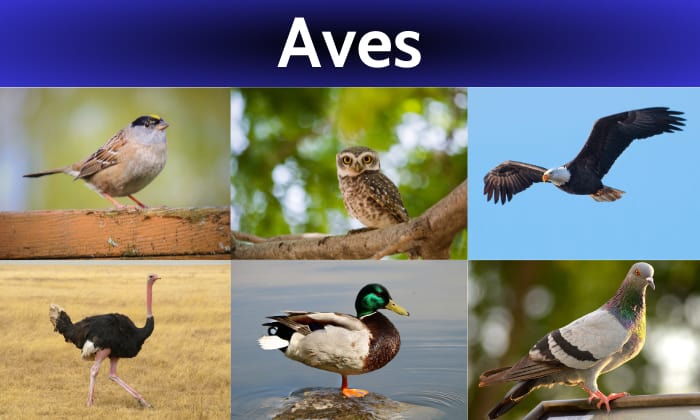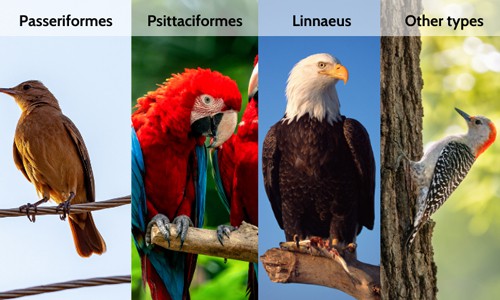“What’s in a name? That which we call a rose, by any other word, would smell as sweet,” says Juliet in Shakespeare’s play Romeo and Juliet.
Going by the system developed by Carl Linnaeus in the 1700s, though, there’s plenty in a scientific name. Scientific names allow people to form a picture of the animal’s appearance, who they are related to, and their evolutionary history.
What is the scientific name for birds? Birds are from the class “Aves.”
How does an animal become classified as an aves, and what are some bird classification subgroups (“orders”)? Read on to learn more!
Table of Contents
An Overview of Class Aves
All living creatures are given “scientific names” based on their physical appearances and evolutionary history.
Here’s a brief look at its history, evolution, and application on birds.
1. Bird Definition And Unique Characteristics
According to the accepted taxonomic practices, the “aves” or birds category includes warm-blooded vertebrates that are feathered, lay hard-shelled eggs, and have:
- Wings (but don’t necessarily fly)
- Toothless, beaked jaws
- A four-chambered heart
- A lightweight skeleton
- Two feet
Birds are considered living dinosaurs because of their close relation to the extinct giants of the past. This is reflected in their scientific name: aves birds are descendants of the avialans (theropod dinosaurs) of the late Jurassic period. An avialan.
2. The Importance of Scientific Names
Why do animals need a Latin name? Why not just go by each one’s common name? The main reason is that many birds have multiple, overlapping names.
For instance, the starling in Europe became known as the European starling in the United States. American goldfinches are also known as wild canaries, different from common canaries.
In short, common names for birds are unreliable since they differ per country and sometimes even per region. Scientific names, however, stay consistent anywhere, making it easier to ensure everyone is discussing the same species.
Birds science name also provides clear, simple clues to each species’ evolutionary history and which species are related.
However, it wasn’t always that way!
An American goldfinch, also known as a wild canary.
3. History and Evolution

Although Carl Linnaeus was the one to devise modern taxonomic classification, he was far from the first scientist to attempt to give “scientific names” to living organisms.
Until the 18th century, many zoologists assigned living organisms Latin names but seemed to do so randomly. The names were inconsistent and too complicated, making them ineffective.
Linnaeus sought to fix the problem by simplifying the process by giving each organism only two names (its “binomial nomenclature”). Using his system, scientists simply refer to each one’s genus and species when referring to the animal.
Linnaeus’ system is still in use today, with numerous modifications to include advances in science and technology. Currently, plants and animals receive eight classification levels from kingdom to species.
4. Classification of Bird Scientific Names
Within the class aves, birds are further grouped according to similar characteristics and features.
- Passeriformes or passerines are the family classification of birds with three unwebbed toes in the front and one strong toe in the back, which helps them perch. This group is more commonly known as the order of perching birds.
- Psittaciformes, or the parrot birds family, are considered the sister group of Passeriformes. They are characterized by their sturdy, curved bills, upright stances, strong legs, and zygodactyl feet (two front-facing and two back-facing toes).
- Linnaeus also specified one order for birds of prey: Accipitriformes. This can be divided into four genera, namely Vultur (vultures), Falco (falcons, eagles, and hawks), Strix (owls), and Lanius (shrikes).
- Other types of bird orders include Piciformes (woodpeckers), Coraciiformes (kingfishers, bee-eaters, etc.), Pelecaniformes (pelicans, herons, ibis, etc.), Columbiformes (pigeons), and Cuculiformes (cuckoos).
Common Birds And Their Scientific Names
Here are common bird names and their scientific name list:
| Common Name | Scientific Name |
| American crow | Corvus brachyrhynchos |
| Goldfinch | American Goldfinch: Spinus tristis
European Goldfinch: Carduelis carduelis |
| American robin | Turdus migratorius |
| Bald Eagle | Haliaeetus leucocephalus |
| Chickadee | Black-capped Chickadee: Poecile atricapillus
Carolina Chickadee: Poecile carolinensis |
| Blue jay | Cyanocitta cristata |
| Chicken | Gallus gallus domesticus |
| Cuckoo | Cuculidae Cuculiformes |
| Dark-eyed junco | Junco hyemalis |
| European starling | Sturnus vulgaris |
| Falcon | Falconidae falco |
| Finches | House Finch: Haemorhous mexicanus
Purple Finch: Haemorhous purpureus |
| Common grackle | Quiscalus quiscula |
| Sparrows | Chipping sparrow: Spizella passerina
House sparrow: Passer domesticus Song sparrow: Melospiza melodia |
| Mallard | Anas platyrhynchos |
| Mourning dove | Zenaida macroura |
| Northern cardinal | Cardinalis cardinalis |
| Tufted titmouse | Baeolophus bicolor |
| Woodpeckers | Downy Woodpecker: Picoides pubescens
Hairy Woodpecker: Leuconotopicus villosus |
| Wrens | Carolina Wren: Thryothorus ludovicianus
House Wren: Troglodytes aedon |
Conclusion
What is the scientific name for birds? While all birds are aves, hundreds and thousands of subclassifications exist under it, allowing scientists and enthusiasts to be specific when discussing our feathered friends.
Though the names are relatively set, they are still constantly updated with advances in DNA analysis technology. Species are occasionally merged or split into separate subgroups until the present day.
Thankfully, you don’t need to know each bird’s Latin or common name to enjoy their singing or colorful plumage as they fly through your backyard or local park.

George and I became friends after a birdwatching trip with our new group. And we have been enjoying every adventure together. When he told me the idea of establishing a site that shares our experiences and fun, I immediately agreed. After trials and errors, here we have Thayerbirding.


















